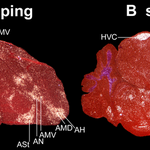Neuroscience

New findings about a protein called the nogo receptor are offering fresh ways to think about keeping the brain sharp.
Scientists have found that reducing the nogo receptor in the brain results in stronger brain signaling in mice, effectively boosting signal strength between the synapses, the connections between nerve cells in the brain. The ability to enhance such connections is central to the brain’s ability to rewire, a process that happens constantly as we learn and remember. The findings are in the March 12 issue of the Journal of Neuroscience.
The work ties together several research…

According to a new study in single-celled organisms, cheating could be genetic. And it could be the same in humans, giving new meaning to the term 'slime mold.'
An international team found that some amoebae have the ability to use cheating tactics to give them a better chance of survival. The research suggests that cheating may be widespread among social creatures - but so are survival instincts. Around other cheaters, or when cheating would place all in peril, the cheating did not occur.
“Slime mould amoebae feed off bacteria in the soil but when food becomes scarce they aggregate to form…

Individual genes do not cause depression, but they are thought to increase the probability of an individual having a depression in the face of other accumulating risk factors, such as other genes and environmental stressors.
One gene that has been shown to increase the risk for depression in the context of multiple stressful life events is the gene for the serotonin transporter protein. This gene is responsible for making the protein that is targeted by all current drug treatments for depression.
In a number of studies it has been shown that people who inherit one form of this gene, called…

Though they perch far apart on the avian family tree, birds with the ability to learn songs use similar brain structures to sing their tunes. Neurobiologists at Duke University Medical Center now have an explanation for this puzzling likeness.
In all three groups of birds with vocal learning abilities – songbirds, parrots and hummingbirds – the brain structures for singing and learning to sing are embedded in areas controlling movement, the researchers discovered. The team also found that areas in charge of movement share many functional similarities with the brain areas for singing. This…

Bipolar Disorder (BPD or manic-depressive illness) is one of the most serious of all mental disorders, affecting millions of individuals worldwide. Affected individuals alternate between states of deep depression and mania. While depression is characterized by persistent and long-term sadness or despair, mania is a mental state characterized by great excitement, flight of ideas, a decreased need for sleep, and, sometimes, uncontrollable behavior, hallucinations, or delusions.
BPD likely arises from the complex interaction of multiple genes and environmental factors. Unlike some brain…

Scientists have discovered epigenetic changes (i.e. chemical changes to a gene that do not alter the DNA sequence) in individuals with schizophrenia and bipolar disorder. This is the first epigenome-wide investigation in psychiatric research, and this groundbreaking data may be a significant step on the journey to fully understanding major psychosis.
Dr. Arturas Petronis, senior scientist in the Krembil Family Epigenetic Laboratory at the Centre for Addiction and Mental Health (CAMH), and his team studied 12,000 locations on the genome using an epigenomic profiling technology developed at…

New research suggests that humans are not as fooled as they seem when viewing visual illusions.
Ben-Gurion University of the Negev Psychologist Tzvi Ganel, writing in the March issue of Psychological Science, says we process images in two very distinct ways. He and his colleagues presented research participants with the “Ponzo” illusion, an image common in psychological research that makes two objects that are similar in length appear drastically different. They then hooked participants’ index finger and thumb to computerized position tracking equipment and asked them to grasp the objects…

Scientists funded by the Biotechnology and Biological Sciences Research Council (BBSRC) have published new research in Molecular Pharmacology identifying the structure of a receptor in the brain implicated in conditions such as epilepsy and pre-menstrual tension. The same receptor has also been reported to be highly sensitive to alcohol.
The University of Cambridge team, in collaboration with colleagues at Aston University and the University of Alberta, have determined the arrangement of the constituent parts of an uncommon but important type of GABA receptor in the brain. GABAA receptors in…

LONDON, March 7 /PRNewswire/ -- Cannabis-derived medicines may one day be used in the treatment of Alzheimer's disease which affects 417,000 people in the UK.
Professor Raphael Mechoulam of the Hebrew University of Jerusalem, Israel, will present new findings to a group of international experts at a Cannabinoids Medicines Symposium to be held at the Royal Pharmaceutical Society of Great Britain (RPSGB) in London on Monday, 10 March. The research, still at an early stage, indicates that memory loss, the main symptom of Alzheimer's, can be slowed down significantly in mice by some of the…

The discovery of the brain’s so-called melanocortin system and its central role in controlling appetite has paved the way for entirely new possibilities for treating obesity and anorexia. In the latest issue of the prestigious journal Nature Reviews Drug Discovery, Uppsala University researcher Jarl Wikberg and one of his associates present a review of pioneering research in this field that he and other scientists have conducted over nearly two decades.
The mapping of the melanocortin system was made possible by the cloning of genes for five different melanocortin receptors, which was…